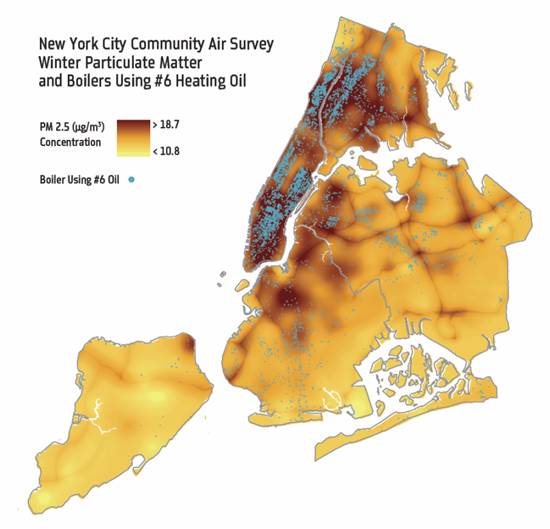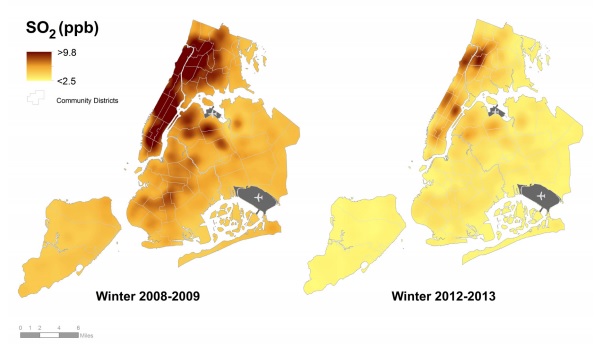March 30, 2015
Clean air? Not without clean heat, says the Environmental Defense Fund
 We’re quite proud of the work we do here at Bike New York to promote cycling as an environmentally conscious and sustainable means of zero-emissions transportation and recreation—but we’re not the only ones working to make NYC a healthier, cleaner place. This year we’re proud to announce the Environmental Defense Fund as a sponsor of the TD Five Boro Bike Tour (which is itself no slouch when it comes to environmental concerns; last year the Tour was the first-ever sporting event in NYC to be certified sustainable by the Council for Responsible Sport). We were honored recently to catch up with Abbey Brown for the first in a series of interviews with officials at EDF—she’s their NYC Clean Heat Coordinator—which “works to preserve the natural systems on which all life depends.”
We’re quite proud of the work we do here at Bike New York to promote cycling as an environmentally conscious and sustainable means of zero-emissions transportation and recreation—but we’re not the only ones working to make NYC a healthier, cleaner place. This year we’re proud to announce the Environmental Defense Fund as a sponsor of the TD Five Boro Bike Tour (which is itself no slouch when it comes to environmental concerns; last year the Tour was the first-ever sporting event in NYC to be certified sustainable by the Council for Responsible Sport). We were honored recently to catch up with Abbey Brown for the first in a series of interviews with officials at EDF—she’s their NYC Clean Heat Coordinator—which “works to preserve the natural systems on which all life depends.”
Hi Abbey! First of all, can you tell us how long you’ve been working for the Environmental Defense Fund? What exactly do you do over there?
Hello! I’ve been at EDF for just about three years, working for the Clean Energy program. EDF is an environmental non-profit headquartered in New York, representing more than 700,000 members and supporters nationwide. EDF links science, economics, law, and policy to create breakthrough solutions to the most serious environmental problems. I’m a project coordinator helping to move our work forward in New York City.
As cyclists, we’re all too aware of how terrible cars can be for air quality, but apparently they aren’t the worst offenders.
So, it all started when some EDFers in our New York office looked out the window and saw thick plumes of blacks smoke coming out of a nearby building. They wondered what was causing it and what the effects were, so EDF did a scientific report on the issue and found that buildings emit 86 percent of the city’s soot pollution from dirty heating oils—which was more soot pollution than comes from the city’s cars and trucks combined. Surprising, right?
Since EDF was already working closely with the Bloomberg administration regarding PlaNYC, it seemed like a natural next step that we work with the City to solve the problem. Together, we created the NYC Clean Heat program, which helps buildings switch from the highly polluting No. 6 and No. 4 heating oil, to cleaner-burning Ultra-low Sulfur (ULS) No. 2 oil, natural gas or biodiesel.
The program acts as a hub of resources for buildings. Converting to cleaner fuels is a complex process, and the NYC Clean Heat team is here to help. By performing outreach, providing technical assistance through the conversion and connecting buildings to financing, NYC Clean Heat has dramatically improved the air quality in NYC.
Oh yeah? How effective has it been?
Very! More than 4,000 buildings have converted to cleaner fuels, and soot pollution from buildings in New York City has fallen by more than 50 percent since 2011.

How important is it to breathe clean air?
Well, there is a study that found that children who breathe cleaner air when they’re young do have improved lung health, and grow up to have a lower chance of developing heart and lung health issues. By reducing the amount of dirty heating oil burned in the city, we’re reducing the amount of soot being emitted. This has prevented an estimated 800 deaths and 2,000 hospital visits due to lung and cardiovascular diseases annually, according to the NYC Department of Health.
So your work literally helps us all breathe a little bit easier. What has the reaction been?
Yeah, it’s been great. Since the results are so quantifiable, it’s easy for people to understand how they’re being helped. In fact, New York magazine named improved air quality one of the reasons to love NYC in 2013. Also, NYC Clean Heat has been recognized twice for outstanding program design. It’s been so successful that it’s also the blueprint for a new city program focusing on full-building energy efficiency. Not just the heating oils but the windows and the air conditioners and the light bulbs. The program will make sure NYC buildings are functioning as efficiently as possible and not wasting energy. Energy efficiency is a key tool in the fight to combat climate change and one that is often ignored.

Before and After the NYC Clean Heat program
The green cubes represent the amount of particulate matter (PM2.5, a.k.a. “soot”) emitted
(image credit EDF & CarbonVisuals)
Awesome. What’s next for NYC Clean Heat?
EDF is all about replicating results, so we really hope what has been successful here in New York can be successful elsewhere, and with other issues. This summer the City is going to be launching the “Retrofit Accelerator,” which is the energy efficiency program I was talking about. We will take the NYC Clean Heat model of providing technical assistance and financing help to building owners and expand it to encompass building-wide energy efficiency. We have high hopes for that, and I think this program model can be successful in other cities around the country and the rest of the world.
What can the average New Yorker do to help improve air quality in New York?
Well, in terms of Clean Heat, you can go to our website and check if you building is burning No. 6 or No. 4 oil. The program is here to help! Generally, New Yorkers live pretty sustainable lives because of how densely the city is built and our public transit, but there’s always more you can do. Biking instead of driving, for instance, or unplugging your chargers when you’re not using them. Every little thing counts!
Learn more about the Environmental Defense Fund on their website: www.edf.org

